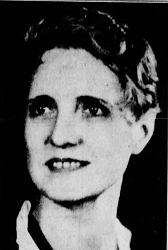
| Medical Center | Frieda S. Robscheit-Robbins |
 |
| Frieda S. Robscheit-Robbins in 1934 |
| Other Pictures of Frieda S. Robscheit-Robbins | |||||
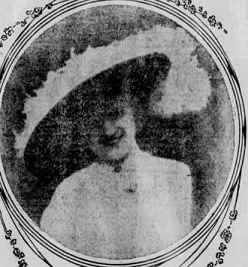 |
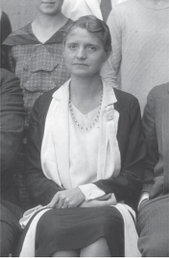 |
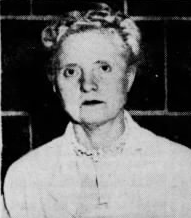 |
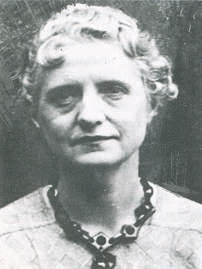 |
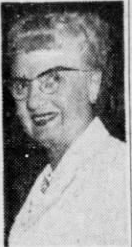 |
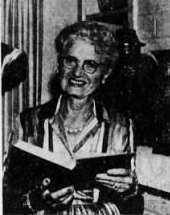 |
| 1915 | 1929 | 1946 | 1955 | 1955 | 1961 |
Friedericke Mathilde Saur was born in the Rhineland on June 8, 1888. Her mother, Eugenie Marie Mathilde Schwarz, was born January 18, 1868 in Duisburg, Germany. Eugenie married Peter August Schwarz sometime before 1900, The family emigrated to the United States in 1900 and resided in Chicago and San Francisco. Eugenie is noted as widowed in the 1920 federal census and divorced in the 1930 census.
Frieda studied at the University of Chicago and University of California, but did not receive degrees. On July 28, 1915, Frieda married Hans Theodore Robscheit, a salesman for the Great Western Power Company who had been born in East Prussia on December 3, 1884 and emigrated in 1910. Frieda and Hans had a daughter, Gene Charlotte, who was born on June 30, 1917 in San Francisco. They changed their last name from Robscheit to Robbins in 1920 or 1921, but Frieda had published as Frieda Robscheit so afterwards used Robscheit-Robbins in her academic work. Frieda began work as a research assistant for Dr. George Hoyt Whipple in 1917. Whipple moved to Rochester in 1921 to become Dean of the new University of Rochester School of Medicine and Dentistry. Frieda continued their research in San Francisco and became the second employee of the new School of Medicine and Dentistry in July 1922. In December, she moved to Rochester accompanied by 40 research dogs that were carried in a special Railway Express car. Frieda's mother and daughter traveled to Europe and returned on September 2, 1923, after which they and Hans came to Rochester. Hans and Frieda divorced in the late 1920s.
Whipple received a Nobel Prize in 1934 and gave credit to Frieda. He also shared the award money with her and two other assistants. She authored more than 100 publications on liver and blood diseases and blood regeneration, as well as several chapters of medical text books. She was the first woman president of the American Society of Experimental Pathology in 1951-1952. A 1961 article mentions a three-volume compilation of her writings, but no other record of these volumes has been found.
Frieda S. Robscheit-Robbins married Oscar V. Sprague, later superintendent of the Kodak Park power plant on January 27, 1951. She retired from the University in 1955 and after Oscar retired from Eastman Kodak in 1958 they moved to Tucson, where Frieda died on December 18, 1973.
Frieda's daughter Gene attended the University of Rochester for three years in the late 1930s but did not graduate. She married James Harper Root III on April 3, 1941. The Roots had one son, Lawrence E., who was born on May 15, 1942. Gene received a Masters Degree in History from the University or Rochester in 1948 and was also a graduate teaching assistant. Gene and James divorced at some point and in 1950 she married Henry Albert Reich, who died in 1964. Frieda then married Stanley William Dilloway, a Coast Guard Reserve officer, sometime before 1968. Gene died at F.F. Thompson Hospital in Canandaigua on July 30, 2002. Lawrence E. Root has two children, Betsy and Lawrence, Jr., and lives in Warsaw, New York.
References
1915 "University
Club Man Given License to Wed," The Sacramento Bee, July 29,
1915, Page 5.
A marriage license was issued to Hans Theodore Robscheit, 30, a salesman
for the Great Western Power Company and a member of the University Club
and Miss Friedericke Mathilde Saur, 27, of San Francisco. Both
Robscheit and his bride are natives of Germany and have been in this
country but a few months. The young woman gave her residence as San
Francisco.
1915 "Sacramento
Social Affairs," The Sacremento Bee, July 31, 1915, Page 8.
Mrs. Hans T. Robscheit, who, before his marriage this week, was Miss
Mathilde Saur. The bride is a graduate of the Chicago
University.
1918 World War I Draft
Registration Card, September 12, 1918
Hans Theodore Robscheit, December 3, 1884, 191 Fredericke St., San
Francisco
Production Manager, American Can Co.
Freda M. Robscheit (Wife)
1920 Federal Census. San
Francisco, 12-13 January 1920
Hans T. Robscheit, 35, immig 1910, born East Prussia, Efficiency engineer
car
Frieda Robscheit, 31, immig 1904, born Rhineland, Scientist, Medicine
Gene (daughter), 2 7/12, born california
Eugenie Schway, Mother, 50, widowed, immig 1904, natualized 1909
1921 "How
to Keep Well," by Dr. W.A. Evans, Chicago Daily Tribune,
January 10, 1921, Page 8.
Let us say that. finally, the proof shows the trouble to be a simple
secondary anemia. Whipple, Hoover, and Robscheit have shown that plenty of
good food is the very best form of iron which can be taken. At the very
head of their list stood liver. Lean beef was a close second and heart
third. These meats were eaten cooked.
1921 Passport
application for myself and grand-daughter Gene Charlotte Robbins,
September 21, 1921
Eugenie Marie Mathilde Schwarz, January 18, 1868, Duisburg, Germany.
Resided in Chicago and San Francisco from 1900 to 1921.
Peter August Schwarz, born in Germany, emigrated to U.S in February 1900,
naturalized June 6, 1905.
1922 Collected
Reprints from the George Williams Hooper Foundation for Medical
Research, Volume 6
Frieda S. Robscheit-Robbins, Assistant in Research Medicine, 1917-1922.
1923 List of United
States Citizens for the Immigration Authorities, August 23, 1923, arrived
September 2, 1923.
S.S. Belgenland, sailing from Antwerp, arriving at Port of New
York
Schwarz, Eugenie, by marriage June 6, 1905, home 2090 Fell St, S.
Francisco, Cal.
Robbins, Gene, S. Francisco, Cal., June 30th, 1917
1927 Methods
and Problems of Medical Education, Series Seven, Division of
Medical Education of the Rockefeller Foundation, February 17, 1927.
Pages 15-19: Animal House, by George Hoyt Whipple
1930 Federal Census, Town
of Brighton, April 16, 1930
Freda Robbins, 41, Divorced, Baden Germany, Scientist, University
Jean C. Daughter
Eugenia Schwarz, Mother, 59, Divorced, Baden, Germany
1934 The reserve storage of red cells and hemoglobin and their parent substances during growth in dogs as influenced by diet factors, by Frieda Saur Robscheit-Robbins, Doctoral Dissertation, University of Rochester Medical Center.
1934 Eighty-Fourth
Annual Commencement, The University of Rochester, June 18, 1934
Candidates for the Degree of Doctor of Philosophy - Frieda Saur
Robscheit-Robbins
1934 "Along
the Promenade," by Mildred Bond, Democrat and Chronicle,
November 18, 1934, Page 4D
No Desire for Honors in Dr. Robbins' Life of Long Research
1936 "Dr.
Frieda Robbins to Address Chamber of Commerce Women," Democrat
and Chronicle, October 27, 1936, Page 10.
Doctor Robbins was assistant to Dr. George H. Whipple, dean of the Medical
School, in work for which he received the Nobel Prize. Shortly after
graduation from the University of Chicago, Dr. Robbins went to the
University of California a assistant to Doctor Whipple who was then head
of the medical school there. Her special field ha been research in
connection with anaemia.
1936 The
First Decade 1926-1936
Page 29: As soon as space in the present Animal House was available
in November, 1922, Dr. Bloor and Dr. Whipple moved into temporary quarters
there. Dr. Frieda S. Robbins, who had been associated with Dr. Whipple in
California, was carrying on the anemia research program at the Hooper
Foundation in San Francisco and came to Rochester with the colony of
standardized anemia dogs in December, 1922, taking up her work in the
Animal House.
Page 204: Decennial Honor Roll. The following list contains
the names of all Staff Members and Employees of the School and Hospital
who have been connected with the institution during the whole of the
decade commencing January 4, 1926, the day of opening of Strong Memorial
Hospital.
1921 — Dr. George H. Whipple, September (Appointed May 1921)
1922 — Mrs. Frieda S. Robbins, July
Dr. Walter R. Bloor, September (Appointed and enrolled July 1922)
Herbert Davis, November
Waldo Price, December
1939 Croesus
Class of 1940 31:207
Page 207: Alpha Sigma, Gene Robbins
1941 "Announces
Marriage," Democrat and Chronicle, April 9, 1941, Page 22
Dr. Frieda S. Robbins of East Avenue announces the recent marriage in New
York City of her daughter, Miss Gene Charlotte Robbins, and Lieut. James
Harper Root 3rd of Buffalo.
1946 "Dogs Decorated as Science Aides," Democrat and Chronicle, February 9, 1946, Page 13.
1946 "2 UR Lab Dogs Go Snooty After Honors in New York," Democrat and Chronicle, February 17, 1946, Page 3B.
1946 "Eugenie
Schwarz," Democrat and Chronicle, July 23, 1946, Page 29.
Died Monday, July 22, 1946, of 520 East Avenue. She is survived by a
daughter, Dr. Frieda S. Robbins and a granddauther, Mrs. James Root.
1947 "Council
of Jewish Women Books Mrs. James H. Root," Democrat and
Chronicle, November 9, 1947, Page 4E.
She teaches at U. of R. Graduate teaching assistant in History at
the U. of R. She also is secretary to the Government Department and
teaches political science on the Prince Street campus.
1947 The
American dilemma, 1939-1941, by Gene Robbins Root, M.A. Thesis in
History, University of Rochester
Acknowledgments. The inspiration tor this study is due to Doctor
Dexter Perkins, whose practical scholarship has been a constant goal for
which to strive. I am also deeply indebted to Doctor Glenn Wiltsey for
friendly encouragement and valid criticism, and to Miss Ruth Harper for
the final mechanics of the work. Finally, the entire project is the direct
result of a most patient husband, a healthy child, and truly generous
friends.
1948 Ninety-eighth
Annual Commencement, The University of Rochester, June 22, 1948
Candidates for the Degree of Master of Arts - Gene Robbins Root, History
1950 The
First Quarter Century 1925-1950
Page 133-134: Animal House, by Freida S. Robscheit-Robbins
1951 "Sprague-Robbins
Nuptials Held," Democrat and Chronicle, January 28, 1951,
Page E1
Dr. Frieda S. Robbins to Oscar V. Sprague
1955 "Dr.
Robbins to Retire From Medical School," Democrat and Chronicle,
June 1, 1955, Page 19.
Dr. Frieda S. Robbins, whose studies helped pave the way for the cure of
pernicious anemia, will retire as associate in pathology at the University
of Rochester Medical School June 30. She will mark the end of 32 years'
service.
1957 Planning
and Construction Period of the School and Hospitals 1921-1925.
bu George H. Whipple, M.D.| pdf |
Page 20: During the year 1921-22, Dr. Frieda Robbins in San
Francisco had been carrying on the anemia program which we had planned. A
colony of standard anemic dogs had been collected and studied with great
care. The Hooper Foundation, with friendly cooperation, permitted
Dr. Robbins to continue her laboratory work and occupy a good deal of
space in their animal rooms during that year. A most devoted, loyal and
able associate over the years, Dr. Robbins carried on through this
difficult period most effectively. In December of 1922, Dr. Robbins
brought the entire standard anemia dog colony, numbering about forty,
including puppies, from California to Rochester where they were properly
housed and the research program continued without interruption. The anemia
program was established in the southeast corner of the first floor of the
Research Laboratory.
1959 Hans Theodore Robbins (1884-1959) grave in Cambridge, Massachusetts
1959 "Hans T. Robbins," The Boston Globe, May 18, 1959, Page 21.
1959 "Autobiographical
Sketch," by George Hoyt Whipple, Perspectives in Biology and
Medicine 2(3):253-289 (Spring 1959)
Pages 277-278: When Dr. Bloor and I moved to the Research Laboratory
on the Crittenden tract, we promptly developed space for research. Dr.
Bloor had his work on lipids in progress. Dr. Robbins brought the anemia
colony from the Hooper Foundation and installed these forty dogs in the
laboratory. Dr. Robbins had been working with me on anemia due to
blood loss, and several papers had been published (3 ) dealing with diet
influences on the production of new hemoglobin.
1961 "Doctor
Tells Of Medical Career," The Arizona Daily Star, October
29, 1961, Page B3.
Dr. Frieda Robscheit-Robbins. The author of over 100 publications on
liver and blood diseases and blood regeneration, as well as several
chapters of medical text books, this remarkable woman holds another first
in her field. She was the first woman president of the American
Society of Experimental Pathology in 1950.
1963 George
Hoyt Whipple and his Friends: The Life-Story of a Nobel Prize
Pathologist, by George W. Corner
Pages 102-103: A third name at the head of this report, following
those of Whipple and Hooper, signalized the addition of a new investigator
to the team. The ever-increasing amount of laboratory work required by
Whipple's program caused him to look for a competent aide in the anemia
experiments. Among those who applied for the post was Mrs. Frieda S.
Robscheit, a young women of alert, self-confident bearing whose blond
coloring and a trace of accent told of her German ancestry. Growing up in
Chicago in the care of a guardian who was a physician, she thought of
studying medicine, but first worked in a commercial pathology laboratory
and then, on the advice of the eminent pathologist Gideon Wells, got a job
in the University of Chicago's biochemical laboratories doing routine
analyses. Diverted from medical studies by marriage, she worked for a
couple of years in San Francisco in a physician's private laboratory.
George Whipple had not thought of a woman assistant in work which
involved, as well as a great deal of biochemical analysis, the handling of
a kennel of large, active dogs, plus daily cleaning of the bile-fistula
animals and other hard, messy work of a kind ordinarily done by male
helpers.
When, in the course of his first interview with Mrs. Robscheit, he said
that he didn't think much of having a woman in the dog laboratory, she
snapped back, "Well, then, Dr. Whipple, here is one woman you don't have
to have in your laboratory!" and started for the door. Whipple, amused and
impressed by this show of spirit, called her back and gave her an
appointment as Fellow in Research Medicine.
Frieda Robscheit proved quite capable of handling the bile fistula dogs,
and quickly learned how to leash them to their posts in the laboratory, to
dilate the fistulas, and collect the bile samples. As the anemia work
progressed, her extensive technical experience, combined with a woman's
instinct for housekeeping, added system and precision to the daily
experimental work. She took charge of breeding the dogs, trained them to
cooperate in the experiments, made up the basal and experimental diets,
and supervised the blood chemistry routines. In 1919 her name first
appeared in a scientific periodical as author of a paper comparing various
methods of hemoglobin determination, printed in the Journal of Biological
Chemistry. The next year Whipple nominated her, as a qualified
investigator, for membership in the Society of Experimental Biology and
Medicine. Her surname, Robscheit, incidently, was Americanized about 1922
to Robbins, but on Whipple's advice, to avoid confusion she called
herself, professionally, Robscheit-Robbins throughout her scientific
career.
Page 127: He did not want to interrupt his work on anemia when it
was going rapidly ahead. Summing up the situation, he thought best to
begin at Rochester without delay, and proposed that the University of
Rochester should assume the expenses of the anemia work while it was
continued temporarily at San Francisco in the care of Frieda
Robscheit-Robbins. Karl Meyer, who was to succeed him as director of the
Hooper Foundation, had generously agreed to keep the necessary laboratory
space available.
Page 131: In December Frieda Robscheit-Robbins arrived shortly ahead
of her 40 dogs: 22 adults and 18 puppies of various ages. There had been a
good deal of amusement at the Hooper Foundation before her
departure. Somebody suggested a circus car with a brass band for
this unusual transcontinental journey. Actually the Railway Express
Company provided a special baggage car in which the dogs traveled
comfortably in individual cages with their own supply of dog food and an
attendant to feed and water them. They reached Rochester in excellent
condition; Mrs. Robbins was able to resume the experimental program with
scarcely a break in its schedule.
Page 297: Whipple shared his one-third portion of the monetary award
with Frieda Robscheit-Robbins and her two technical assistants, Marie M.
Callahan and Doris E. Huxley, who for many years had taken part in the
anemia work. He gave the balance of his portion to his mother, Anna Hoyt
Whipple, in acknowledgment of the sacrifices she had made for his
education and professional training.
Pages 299-321: Bibliography of Whipple's publications, also includes
many (perhaps all?) of Robscheit-Robbins works.
1964 "Book Reviews. George Hoyt Whipple and His Friends. The life-story of a Nobel prize pathologist. George W. Corner. Lippincott, Philadelphia, 1963. xii + 355 pp. $5.50" by Stanhope Bayne-Jones, Science 143(3604):346-347 (January 24, 1964)
1964 "Henry
A. Reich, 60, Retired Retailer, Dies," Democrat and Chronicle,
May 9, 1964.
Retired vice president of the B. Forman Co., died Thursday (May 8, 1964)
at Fishers, where he had made his home. He leaves his widow, Mrs.
Gene Reich.
1965 "UR's
Old Animal House Reduced to Rubble Pile," Democrat and Chronicle,
February 13, 1965, Page 3B.
About 40 of the dogs, half of them pups, were transported across the
continent from San Francisco, where Dr. Whipple and his chief research
associate, Mrs. Frieda Robscheit-Robbins, had developed the breed for
studies in anemia.
1968 "Oscar
V. Sprague," Tucson Daily Citizen, December 7, 1968, Page
23.
Oscar V. Sprague, 76, of 4801 E. Broadway, passed away December 6th. He is
survived by his wife, Frieda, of Tucson; a daughter, Mrs. Stanley
Dilloway, of Pittsford, New York; and a grandson, Capt. Lawrence Root, in
the Air Force in Thailand.
1972 History
of the American Society for Experimental Pathology: A Record of Its
Annual Meetings with Brief Biographical Sketches of Its Officers,
by Esmond Ray Long
Page 155: Frieda S. Robscheit-Robbins, Thirty-fifth president,
1951-1952
Frieda S. Robscheit-Robbins (Mrs. Oscar V. Sprague) (1893- ) ,
thirty-fifth president of the ASEP (1951-1952), and its
secretary-treasurer from 1946 to 1949, was born in Euskirchen, Germany,
June 8, 1893, emigrated to the United States, and in 1917 became an
assistant in the Hooper Foundation for medical research under G. H.
Whipple in the school of medicine of the University of California. She
remained in this position until 1922. In that year she rejoined Whipple's
staff ·at the new school of medicine of the University of Rochester, with
the rank of associate in pathology. She continued in this fruitful
research environment until her retirement in 1958, carrying on an
intensive program of research initiated in California in 1917 when she
first joined the Whipple staff. She took a Ph.D. degree in experimental
pathology at Rochester in 1937, and was a recognized authority in studies
of blood, anemia and essential dietary factors.
During her years of active research she was a continuous participant in
the scientific programs and administrative sessions of the ASEP. Her first
papers were presented before the Society in association with Whipple in
the early l920's. She supervised the movement of the Hooper Foundation dog
colony from California to Rochester in 1922 and continued studies on
anemia with Whipple and others of his associates that Jed to recognition
of the importance of a liver factor in blood regeneration. In succeeding
years she carried out an uninterrupted program of research on blood
proteins, essential amino acids, anemia, blood volume, liver physiology,
blood gases and iron absorption and metabolism. In 1958 she moved to
Tucson, Arizona, in retirement.
1973 Social Security
Death Index
Frieda Sprague, birth date June 8, 1888, died December 1973
1973 "Dr.
Sprague, Researcher of Anemia, Dies," The Arizona Daily Star,
December 20, 1973, Page 16.
Dr. Frieda S. Robscheit-Robbins
1975 To
each his farthest star: The University of Rochester Medical
Center -1925-1975, edited by Edward C. Atwater and John
Romano.
Page 46: George Whipple, anxious to resume the research he had left
in San Francisco to be carried on by his very competent assistant, Frieda
Robbins, started in August 1922 the construction of a small two-story
building on the Crittenden site, ultimately to house experimental animals
but temporarily to accommodate the professors until the School and
Hospital building was ready for them. The animal house was finished in
November. Whipple set up a laboratory there in time to receive his forty
dogs that Mrs. Robbins brought from San Francisco in December.
Page 65: Every department chairman set an example in research
initiation, and Dean Whipple above all in that he transplanted his special
dogs and his research associate (Mrs. Frieda Robbins) from the University
of California.
Page 421: George Whipple and his associates established the value of
liver in promoting blood regeneration in the anemic dog-it was that paper,
noted in the list of references immediately following (only one of many on
this general topic), which set Whipple on the road to the Nobel
Prize. (The Journal of Experimental Medicine, his favored
publication, would have been much thinner had it not been for the stream
of papers which poured forth from the pens of this indefatigable
researcher, his colleague Frieda Robscheit-Robbins, and their associates.)
1981 "George
H Whipple or How to Be a Great Man Without Knowing Differential
Equations," by Horace.W. Davenport, The
Physiologist 24(2):1-5 1981
Page 4: Let me stop a this point to pay a tribute to Frieda
Robscheit-Robbins. She was the woman who saw that Whipple's research on
blood regeneration was done and done right. She had little formal
training; she started out as a technician who knew what she was doing. The
University of Rochester gave her a Ph.D., so she was Dr.
Robscheit-Robbins. When 1 was at Rochester I had very little to do with
her, for I was very junior and she was very senior indeed. But I did have
something to do with her when I was President of the American
Physiological Society and she was President of the Society for Expenmental
Pathology, which is pretty good for a technician without much formal
training. The older persons who attended Federation meetings in those days
will remember her. She was always beautifully dressed, and her hair was
elegantly coiffeured. She wore striking hats and real diamonds. She was a
lady of considerable presence.
1992 "James
H. Root III," Asheville Citizens-Times (Ashville, North
Carolina), September 30, 1992, Page 3B.
Maj. James Harper Root III, 78, died Tuesday, Sept. 1, in a local
hospital. Root was an export manager for Taylor Instrument in Asheville.
He served in the U.S. Army for 27 years and was a company commander in the
28th Division during World War II. His awards include four bronze stars,
the Combat Infantry Badge and Croix de Guerre with Palms presented by the
French government. He was an amateur historian, a member of the Sons of
the American Revolution, the Order of the Founders-and Patriots of America
and the National Association of Military Historians. He is survived
by one son, Lawrence E. Root Sr. of Livonia, N.Y.; one brother, Dr.
William R. Root of Buffalo, N.Y. and two grandchildren.
1995 "George Hoyt Whipple, 1878-1976 : a biographical memoir," by Leon L. Miller, Biographical memoirs of the National Academy of Sciences 66:371-393 (1995)
1998 Nobel
Prize women in science: their lives, struggles, and momentous
discoveries, Second Edition, by Sharon Bertsch McGrayne and
Ardashes Hamparian
Frieda Robscheit-Robbins 1893–December 18, 1973
For thirty-eight years Frieda Robscheit-Robbins was the research partner
of George Hoyt Whipple. Although their joint work led to a cure for the
deadly disease pernicious anemia, it was Whipple alone who won a Nobel
Prize for Physiology or Medicine in 1934.
“Whipple’s experiments,” the Nobel Committee observed, “were planned
exceedingly well and carried out very accurately, and consequently their
results can lay claim to absolute reliability.” Frieda Robscheit-Robbins
helped to plan and carried out those experiments.
In fact, she was listed as the first author on Whipple’s most important
single paper, the report on which his scientific reputation rested.
Generally, the first author is primarily responsible for the work
summarized in the paper.
Whipple cited twenty-three scientific papers in his Nobel address.
Of these, Robschiet-Robbins was the coauthor of ten. Whipple shared his
prize money with Robscheit-Robbins and with two women technicians.
Frieda Robscheit-Robbins was born in Germany, educated in Chicago and
California, and received her Ph.D. from the University of Rochester. She
worked with Whipple from 1917 until her retirement from the University of
Rochester Medical School in 1955. After thirty-eight years, she was still
an associate in pathology, a junior-grade employee.
Of scientific research, she said, “You become possessed of a magnificent
obsession and determination to learn the truth of your scientific theory
if it takes sixteen years or many times sixteen. If you are successful,
you really deserve no great credit, for by that time experiment has become
the only thing in life you care to do.”
2002 "Gene
Dilloway," Democrat and Chronicle, August 1, 2002, Page 2B.
Frieda's daughter
2007 Dictionary
of Women Worldwide 2:1016
Robscheit-Robbins, Frieda (1888–1973)
American pathologist. Name variations: Frieda Sprague. Born June 8, 1888,
in Germany; died Dec 1973 in Tucson, Arizona; University of Chicago, BS;
University of California, MS; University of Rochester, PhD; married O.V.
Sprague.
Moved to US when young; began working with George Whipple at University of
Rochester (1917) and remained his research partner for 18 years; with
Whipple, conducted research on iron metabolism, discovering factors which
cause pernicious anemia, and the usefulness of liver therapy in treatment
of the disease; published 21 papers with Whipple (1925–30); was passed
over for Nobel Prize (1934), which was awarded to Whipple, though he did
share prize money; after Whipple's death, continued research until
retirement (1955), still only an associate professor.
2009 "Stanley W. Dilloway," Democrat and Chronicle, July 5, 2009, Page 2B.
2020 A Pathway to Excellence: The First 100 Years of Pathology and Laboratory Medicine at the University of Rochester School of Medicine and Dentistry, 1921-2020, by Bruce R. Smoller
Articles
written by Frieda S. Robscheit-Robbins
1920
1922 Collected
Reprints from the George Williams Hooper Foundation for Medical
Research, Volume 6
This volume includes several articles written by Frieda S.
Robscheit-Robbins
1929 "The Regeneration of Hemoglobin and Erythrocytes," by F.S. Robscheit-Robbins, Physiological Reviews 9(4):666-709 (October 1929)
1932 "The response of reticulocytes to potent diets in severe experimental anemia due to hemorrhage," by Janet Rioch and F.S. Robscheit-Robbins, American Journal of the Medical Sciences 184(3):304-313 (September, 1932)
1933 "Diet and its effect upon blood formation," by F.S. Robscheit-Robbins, Journal of the American Dietetic Association 9(5):387-395 (January 1933)
Also see the archives of the American Journal of Physiology for other articles
© 2021 Morris A. Pierce